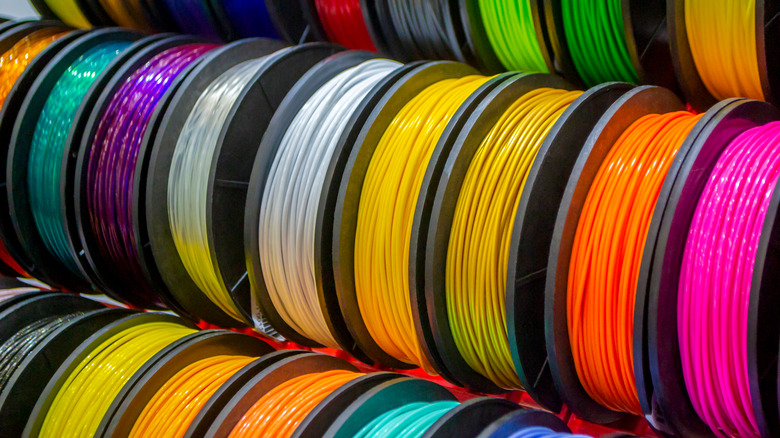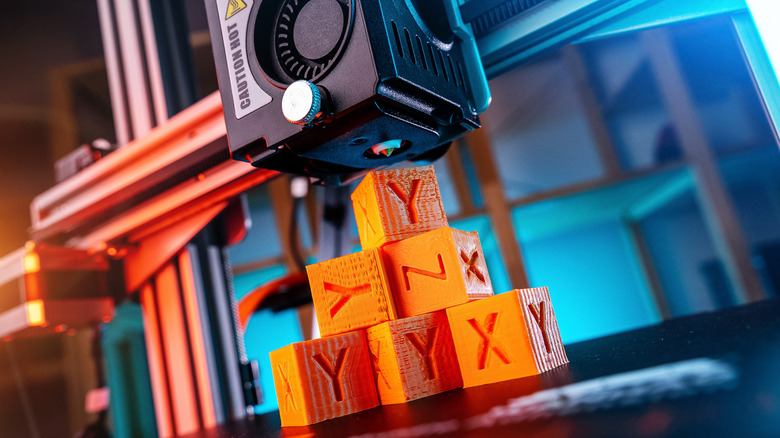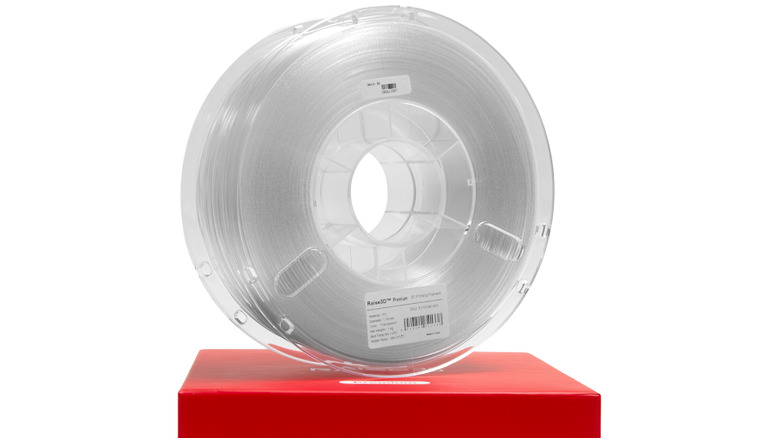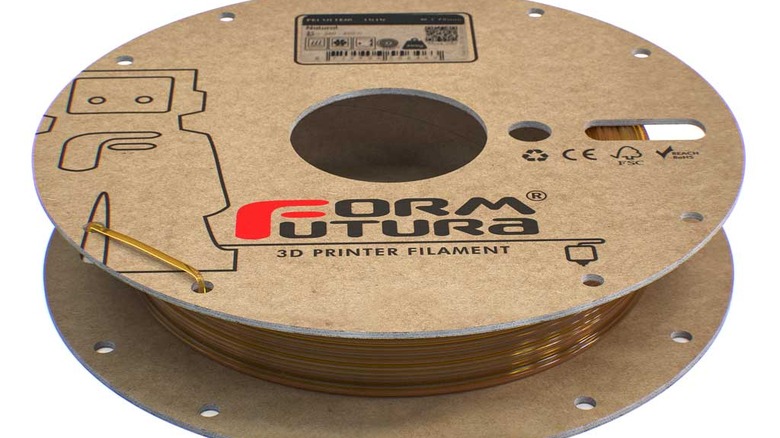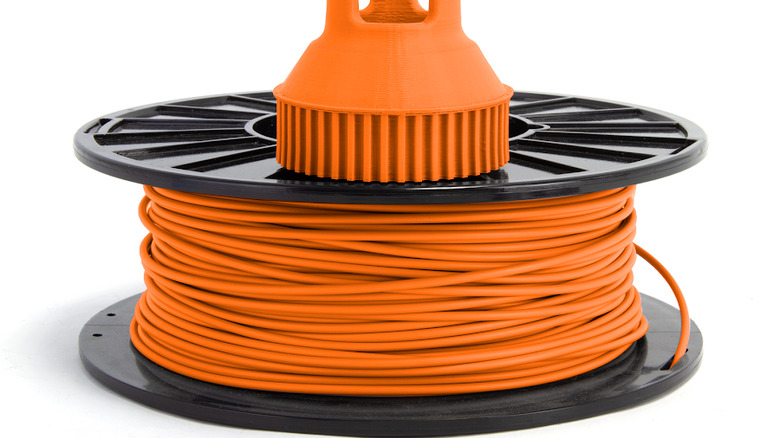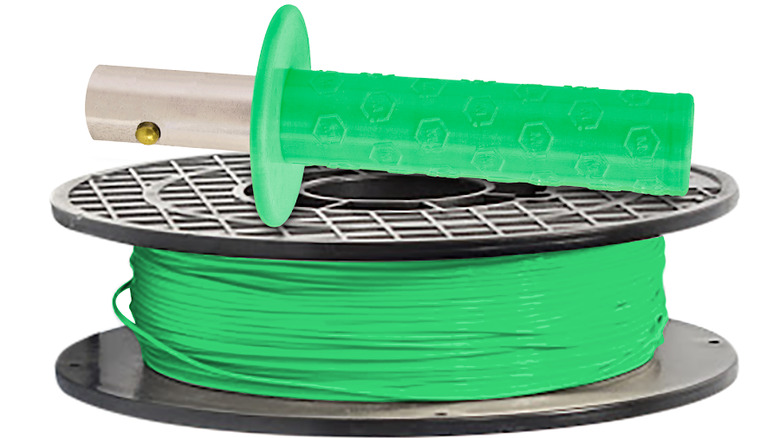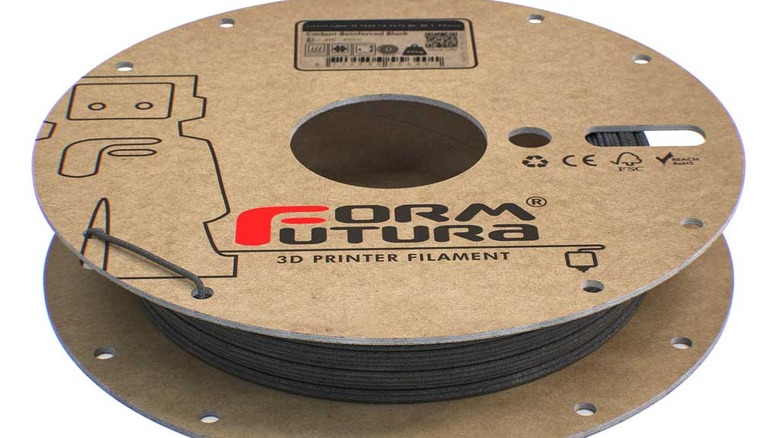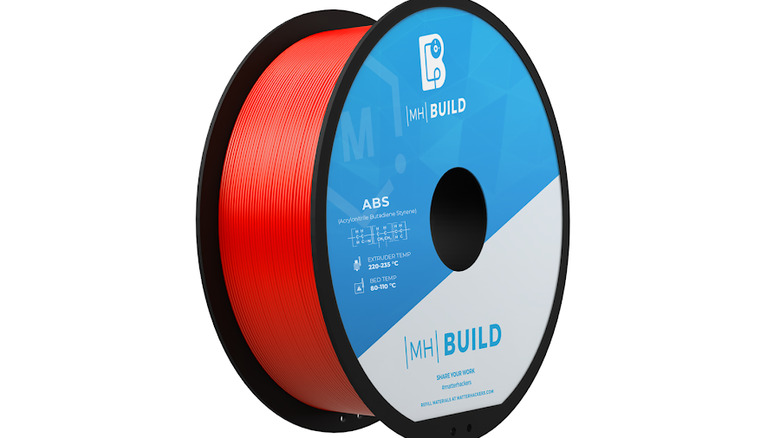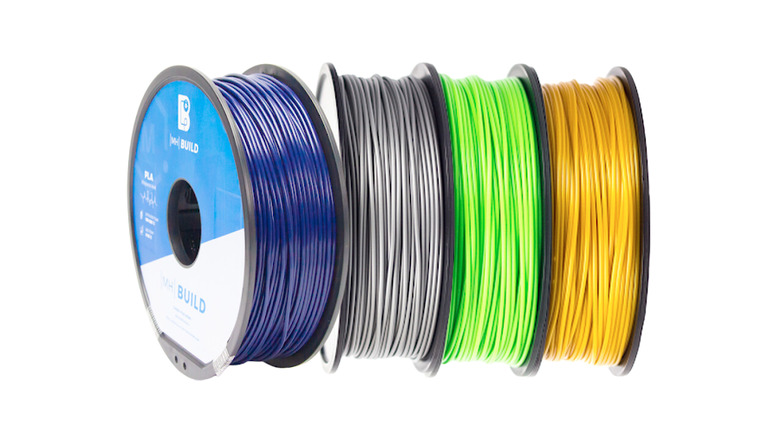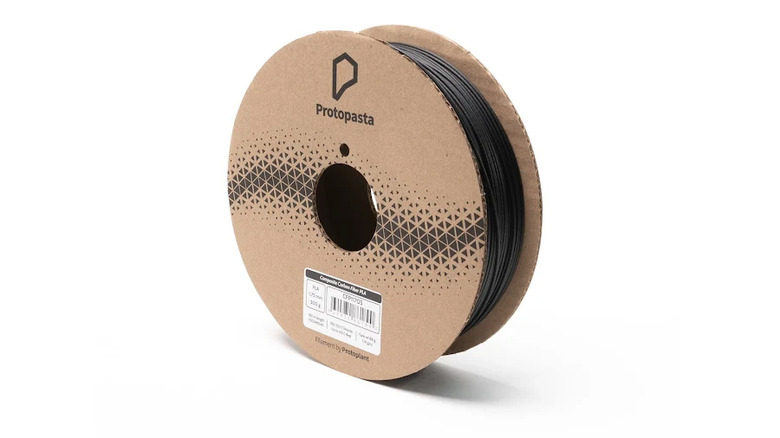8 Of The Most Durable Consumer-Grade 3D Filaments, Ranked
3D printing is undoubtedly one of the coolest consumer technologies to truly explode in popularity in recent years. As 3D printing becomes more and more popular, and more people have access to 3D printers, a great deal of variety results with respect to what things are being printed. With that variety, there becomes an issue of what exactly should be 3D printed.
Whether you're fabricating prototypes for a larger project or simply fashioning intricate household items, the resilience of your printed creations can make all the difference between success and failure. There are, ultimately, some things that might not be meant to be made from any given 3D printer filament. One of the biggest concerns you might have when 3D printing something is whether or not it will be as durable as you want it to be. However, there's no need to give up on a project you have in mind just yet. You may just need to take a better look at your options when it comes to picking a filament.
From engineering-grade thermoplastics to cutting-edge composite materials, the quest for the perfect filament is going to require you to do some extensive research as well as a thorough consideration of your needs. What will fit your needs, and what won't? It's also important to consider any potential trade-offs a particular filament has, and how that may affect what you're creating. However, before diving into what the most durable consumer-grade 3D filaments may actually be, it's important to understand what "durability" actually means.
Types of strength
When examining filaments for 3D printing, durability isn't a particularly measurable trait, at least not in the one-size-fits-all sense of the word. Some filaments will be absolute powerhouses in one regard, but crumble under different circumstances. When thinking of strength and durability in the context of 3D printing filaments, we must recognize that these terms are deeply intertwined with the specific needs and requirements of individual users. What constitutes strength for one project may differ significantly from another.
At its core, strength encompasses a spectrum of mechanical properties that can each play a role in the performance and longevity of printed objects. Tensile strength, the measure of a material's resistance to breaking under tension, is going to be important for load-bearing fabrications. Meanwhile, flexural strength dictates a filament's ability to withstand bending without permanent deformation, making it indispensable for projects that will need resilience in the face of more dynamic stressors.
Durability, on the other hand, extends beyond mechanical robustness to encompass a broader array of factors influencing a filament's lifespan and performance. Resistance to environmental factors such as moisture, UV radiation, and chemical exposure can lenghten the life of printed parts, particularly in outdoor or industrial settings where harsh conditions abound. Additionally, considerations such as thermal stability and heat resistance are important for projects that will be subjected to heat; conventional filaments may falter under the intense heat of operational environments.
Ultimately, the definition of strength and durability in 3D printing filaments is fluid, and will change with the objectives of any given project. For some, the ability to withstand extreme temperatures may be paramount; for others, resistance to chemical corrosion may be the top priority. Understanding your needs will help you to make the best choice for your project.
Polycarbonate
Among 3D printing filaments, few materials hold the sort of "go-to" spot quite like polycarbonate. Renowned for its strength, exceptional impact resistance, and versatility across a spectrum of applications, polycarbonate stands as a titan amongst filaments.
Polycarbonate boasts a formidable array of mechanical properties that render it ideal for projects demanding uncompromising durability. With a tensile strength surpassing that of many conventional thermoplastics, polycarbonate excels in applications requiring load-bearing capabilities, such as structural components, machine parts, and automotive prototypes.
One of polycarbonate's greatest attributes is its remarkable impact resistance, making it seem nearly impervious to sudden shocks and collisions that would damage lesser materials. Polycarbonate has such a level of impact resistance that it's used in making bullet-proof glass, among other things. This resilience to impact damage makes polycarbonate an indispensable filament for 3D printing projects that will require any kind of strong impact resistance.
Furthermore, polycarbonate's exceptional thermal stability ensures performance consistency across a broad range of temperatures, from sub-zero environments to scorching heat. This attribute makes it well-suited for applications subjected to extreme operating conditions, such as under-the-hood automotive components and industrial machinery parts.
Another distinct bonus of polycarbonate is that it's lightweight. Despite its durability, polycarbonate stands as a very lightweight option in the face of other materials. Additionally, polycarbonate is a great option for a strong, transparent filament.
Despite its formidable qualities, working with polycarbonate presents unique challenges due to its high melting point and propensity for warping during printing. However, advancements in 3D printing technology, including heated build chambers and specialized print settings, have made it increasingly feasible to harness the full potential of this powerhouse filament.
Polyetherimide (Ultem / PEI)
In the realm of cutting-edge 3D printing filaments, one material stands out as a paragon of durability and versatility: polyetherimide (PEI). Often referred to by its trade name, Ultem, PEI has revolutionized additive manufacturing with its exceptional mechanical properties and resistance to a wide range of environmental stressors.
PEI, much like polycarbonate, does present issues when printing due to its high processing temperatures. This issue can be confronted in much the same way as it can with polycarbonate, with the correct equipment and environment.
At the center of PEI's allure lies its remarkable combination of strength and temperature resistance. Boasting a tensile strength comparable to metals such as aluminum, along with a glass transition temperature exceeding 200°C, PEI is uniquely suited for applications requiring both structural integrity and thermal stability. ULTEM resin is actually one of the only plastic 3D printing filaments that is certified for aircraft components.
One of PEI's defining features is its inherent flame-retardant properties, making it an ideal choice for projects demanding compliance with stringent safety standards. From electrical components to aerospace interiors, PEI's ability to inhibit flame spread and self-extinguish in the presence of fire provides added peace of mind in critical applications.
Additionally, PEI exhibits excellent chemical resistance, withstanding exposure to a wide range of acids, bases, and solvents without compromising its mechanical properties. This resistance to chemical degradation ensures the longevity and reliability of printed parts in environments where exposure to corrosive substances is likely.
Nylon
Not many materials possess the time-tested resilience and versatility of nylon. Nylon can most be noted for its exceptional strength, flexibility, and impact resistance. Derived from polyamide polymers, nylon possesses a unique combination of mechanical properties that make it suited for a wide range of applications. With a tensile strength rivaling even polycarbonate and superior flexibility compared to many other filaments, nylon excels in projects requiring structural integrity and resilience when put up against more dynamic forces.
One of nylon's most notable attributes is its exceptional impact resistance, rendering it impervious to sudden shocks and collisions that would compromise weaker materials. This resilience to impact damage makes nylon an indispensable asset in industries ranging from automotive manufacturing to consumer goods, where durability is paramount.
Furthermore, nylon's inherent flexibility enables it to withstand bending and deformation without succumbing to permanent damage, making it well-suited for applications subject to repetitive stress and strain. This flexibility extends the lifespan of printed parts, ensuring long-term reliability in demanding environments.
Working with nylon does have its hurdles to look out for, including moisture absorption and warping during printing. Moisture absorption in particular can lead to stringing in your 3D printer. Concerning moisture absorption, this issue can be mitigated before use with careful storage of nylon before printing.
TPU (Thermoplastic Polyurethane)
Thermoplastic Polyurethane (TPU) stands out as a versatile option, offering a unique blend of elasticity, durability, and resilience. Derived from a class of polymers known for their exceptional flexibility and toughness, TPU is best sought for its ability to produce flexible, yet durable printed parts suitable for a variety of applications.
One of the primary advantages of TPU as a 3D printing filament is its impressive durability. Unlike rigid filaments that may crack or break under stress, TPU can withstand bending, stretching, and compression without sacrificing structural integrity. Its elasticity allows printed objects to stretch and bend without succumbing to permanent deformation. This property makes TPU an ideal choice for projects requiring components that can withstand repetitive stress and strain, such as flexible hinges, gaskets, and wearable devices. TPU's versatility also extends beyond its durability and strength. Its inherent flexibility allows for the creation of intricate designs and complex geometries that would be challenging to achieve with stiffer materials.
TPU also exhibits excellent abrasion resistance, maintaining its integrity even when subjected to constant friction and wear. This durability makes TPU well-suited for applications in industries such as footwear manufacturing, where printed parts must withstand the rigors of daily use without sacrificing performance.
One of TPU's most celebrated attributes is its ability to maintain flexibility across a wide range of temperatures, from freezing cold to scorching heat. This thermal stability ensures consistent performance in diverse environments, making TPU invaluable in projects where temperature fluctuations are common.
PEEK
Polyether ether ketone (PEEK) stands out as a solid option for performance in 3D printing. PEEK's reputation as a high-performance polymer stems from its outstanding mechanical properties. This thermoplastic material exhibits remarkable resistance to heat, chemicals, and mechanical stress, making it an ideal candidate for applications requiring superior durability and strength.
PEEK is one of the strongest 3D printing filaments out there and, much like polycarbonate, is surprisingly lightweight despite its strength. Unlike conventional filaments that may degrade or weaken over time, PEEK maintains its structural integrity even in harsh operating environments. Its resistance to abrasion, corrosion, and fatigue ensures that printed objects remain robust and reliable throughout their lifespan. PEEK is also not particularly prone to moisture absorption, which allows it to be used in some pretty surprising settings, such as for making medical implants.
PEEK also boasts exceptional strength properties, surpassing many traditional filament materials in terms of tensile strength and impact resistance. Its ability to withstand high loads and stresses without deformation or failure makes it an indispensable choice for engineering components, structural parts, and functional prototypes that require uncompromising mechanical performance.
PEEK also holds up well in high-temperature environments. Of course, this comes with the disadvantage it always does, that being a difficult print. Being as heat-resistant as it is, you'll need one of the best 3D printers with correct specializations to work with it. Another negative consideration when looking at PEEK is price. PEEK is, far and away, one of the most expensive consumer-grade 3D filaments out there, retailing as high as nearly $600 for a kilogram.
ABS
Acrylonitrile Butadiene Styrene (ABS) stands out as a much more budget-friendly alternative to many of the filaments on this list. While certainly not as strong as some of the other options, its utility may very well fit your needs without putting a huge dent in your bank account.
ABS boasts a balanced combination of mechanical properties that make it suitable for a wide range of projects. With a respectable tensile strength and moderate flexibility, ABS excels in applications requiring both structural integrity and resilience to impact forces. One of ABS's most notable attributes is its excellent machinability, allowing for easy post-processing and finishing techniques such as sanding, drilling, and painting. This versatility makes ABS an ideal choice for projects requiring intricate detailing and customization, from scale models to artistic creations.
ABS also has great thermal stability, withstanding temperatures up to 80°C without significant deformation or degradation. This thermal resilience makes ABS suitable for functional parts exposed to moderate heat, such as automotive components, electronics enclosures, and household appliances.
ABS's compatibility with a wide range of solvents and adhesives enhances its versatility in assembly and fabrication processes, facilitating seamless integration of printed parts into larger assemblies. This compatibility extends to secondary processes such as vapor smoothing, which can improve surface finish and aesthetic appeal.
ABS does require careful consideration during the printing process, particularly regarding ventilation and temperature control, due to the release of fumes and its tendency to warp if not properly managed. However, with proper precautions and adherence to best practices, users can harness the full potential of ABS to create durable, strong, and aesthetically pleasing prints.
PLA
Polylactic Acid (PLA) is one of the most budget-friendly, consumer-grade filaments available. It also doesn't have a great reputation for durability. However, there are two major things to keep in mind. Number one is, do you really need top-of-the-line durability? The second thing is that there is more to PLA than you might initially think.
With respectable tensile strength and stiffness, PLA excels in applications ranging from prototyping and architectural models to educational projects and consumer goods. In some cases, you may even find PLA to be a better option than ABS. This strength comes alongside its biodegradability, which sets it apart from traditional thermoplastics derived from fossil fuels. There are some concerns regarding environmental and health risks with 3D printing, but PLA is a filament that looks to mitigate things on the environmental side. When disposed of in appropriate conditions, PLA can break down into harmless byproducts, making it an environmentally responsible choice for 3D printing applications.
One of the greater advantages PLA has over many of the other materials listed is its excellent printability, with minimal warping and shrinkage compared to other filaments. This ease of use makes PLA suitable for both novice and experienced users alike, enabling effortless creation of high-quality prints with minimal hassle.
PLA's limitations present themselves in applications requiring particularly high strength, heat resistance, or chemical durability. However, it is worth taking a step back to truly consider your needs before sinking too much money into a more expensive filament that has attributes that you might not actually need.
Carbon fiber infused materials
When looking at all of the previous filaments, there is one way to make the majority of them better: carbon fiber-infusing. By blending carbon fiber filaments with thermoplastics such as nylon, polycarbonate, or even polyethylene terephthalate (PETG), manufacturers can create a potent combination of strength, stiffness, and resilience previously unattainable with traditional filaments alone.
Carbon fiber-infused materials are made so great by the outstanding strength-to-weight ratio of carbon fiber. Carbon fiber exhibits remarkable tensile strength and stiffness, rivaling that of steel while being significantly lighter. When incorporated into 3D printing filaments, these characteristics imbue printed parts with exceptional mechanical properties, making them ideal for a large variety of applications.
A key advantage of carbon fiber-infused materials is their enhanced stiffness, which allows for greater rigidity and dimensional stability in printed objects. This stiffness translates to reduced flexing and bending under load, making carbon fiber-infused parts well-suited for structural components, machine fixtures, and power tool accessories.
Furthermore, the addition of carbon fiber imparts increased impact resistance to printed parts, providing added resilience against sudden shocks and collisions. This durability makes carbon fiber-infused materials a good fit for making components that must withstand the rigors of daily use without compromising performance. Carbon fiber-infused materials also exhibit excellent heat resistance, maintaining their integrity even when subjected to elevated temperatures.
For many of the other filaments listed, you can find carbon fiber-infused variations of them available for purchase. If durability is lacking from what otherwise would be your ideal material for a project, carbon fiber infusion may be the exact thing that can push a filament from a "maybe" to a "definitely."
